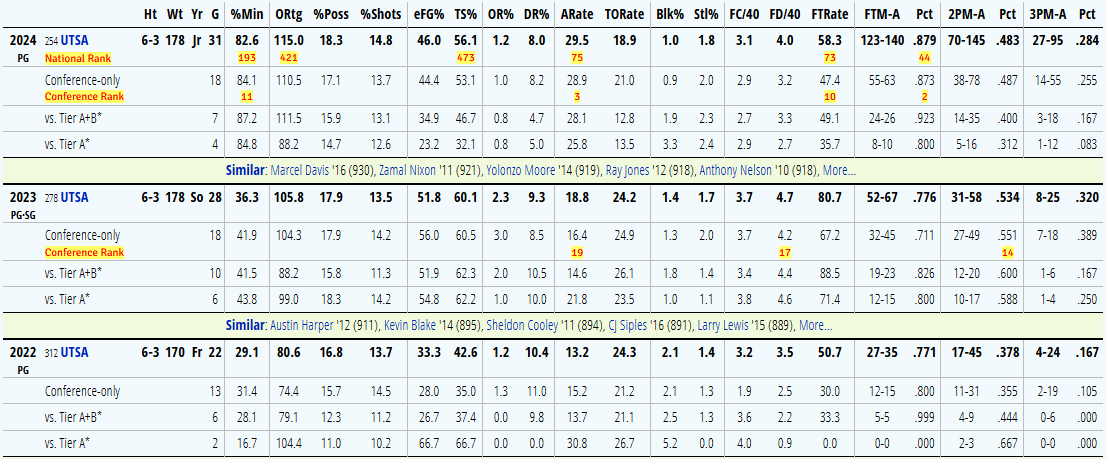Transfer Portal Update: Meet the New Bears
Not quite the same as the old Bears
Well, it didn’t take long for Mark Madsen and his coaching staff to add a bunch of talent for the 2024-25 season. And just in case you haven’t been able to follow along day by day, scouring youtube for highlight packages, I thought it would be helpful to step back and gather everything into one post, while taking some time to try to project out what the new additions to Cal’s roster are likely to bring.
Let’s go one by one:
DJ Campbell, wing, Western Carolina
You’ll see a common theme with many of Cal’s transfer pick-ups - sophomores who got their feet wet in minimal minutes as freshmen, then saw big upticks in court time and production as sophomores before hitting the portal for (hopefully) bigger and better things.
Campbell wasn’t exactly a bench warmer with 14 starts and plenty of minutes as a freshman, but he didn’t shoot much. That all changed as a sophomore, when he took it to the basket much more frequently, drew more fouls, and still managed to slightly cut his turnover rate.
He’s probably not a 40%+ shooter from deep based on his freshmen numbers and the frequency with which Western Carolina asked him to hoist it, but he’s clearly a good enough shooter to stretch a defense. Meanwhile, he rebounds well for his size and was part of the best defense in the Southern Conference last year. Everything suggests a well-rounded role player.
Lee Dort, center, Vanderbilt
Cal’s most (and hopefully only) controversial recruit is also Cal’s highest variable recruit. The #98 overall recruit from the high school class of 2022 has barely seen the basketball court in two seasons thanks to legal issues.
I, frankly, don’t have the information to know if Dort was 100% innocent, or if his brush with the law was a one time error from which he deserves a second chance, or if he committed an offense that should disqualify him from the opportunity to represent Cal basketball. I also don’t know Mark Madsen enough to defer to his background work and character evaluation.
I also don’t have enough information to say what kind of on-court impact Dort might have. He played very limited minutes as a true freshman where he flashed elite rebounding skills but struggled badly with turnovers and fouls. That is not necessarily unusual for a true freshman big . . . and then he played all of seven minutes as a sophomore.
Cal might be getting an athletically elite big who can control the glass and the rim, or they could be getting a player who was raw and has hardly developed thanks to a lack of court time, and that’s setting aside the ethical concerns. Only time will tell, on both counts.
Jeff Nwankwo, wing, Cowley College
As Nwankwo is coming from the JC ranks, we don’t have advanced stats to parse. Still, you don’t need advanced stats to tell that Nwankwo dominated at his level, filling up the box score in a ball dominant role. If Nwankwo came in and replicated his Juco efficiency he’d be an immediate all-conference level performer - dudes who shoot 57% on their 2s and 37% on the 3s at high volume are VERY rare.
That’s almost certainly not a realistic expectation jumping to ACC basketball, but his shooting and size should absolutely translate. For two examples, look at KaSean Pryor and Tre-von Spillers. Both were Juco All-American forwards from 2023 who each had extremely positive impacts at USF and App State respectively last year.
I don’t know if Nkonkwo will be a high usage lead scorer, but at a minimum I’d anticipate that he will start and be a key rotation member.
Josh Ola-Joseph, wing, Minnesota
Now here’s an interesting transfer. Ola-Joseph led Minnesota in offensive efficiency last year thanks to gaudy shooting numbers and a reasonably low turnover rate. And yet he found himself nearly entirely removed from Minnesota’s rotation early in Big-10 play.
Why? Local reporting from Minnesota said it was due to headaches from a concussion, which may be true but it seems weird to treat a concussion by playing a dude 5-8 minutes a game rather than 20. Maybe it was about defense, which was Minnesota’s weakness as a team.
Regardless, Cal appears to be getting an excellent offensive wing. You’d maybe want to see a big more rebounding and a bit less fouling, but that’s also something that might come from further development.
BJ Omot, forward, North Dakota
Omot has an odd statistical profile. He basically plays as a stretch 4, attempting a ton of 3s, but he just hasn’t been a particularly good shooter. ~28% from 3 and ~48% from 2 isn’t amazing. But he has an OK offensive rating because his turnover percentage is microscopic and he draws a ton of fouls and shoots well from the line.
So: Can his shooting develop? Or maybe he’ll just be better being a role player at Cal rather than the go-to option he was at North Dakota. He’ll either have to improve his 3 point shot or cut back drastically on that part of his game, but if he’s an efficient, low-turnover interior scorer with juuuuust enough of a shot to keep defenses honest, that’s something that should be valuable.
Christian Tucker, point guard, UTSA
So let’s start with the most important thing: Tucker is a bona-fide plus pass-first point guard. Tucker’s assist rate last year is higher than any Bear since Justin Cobbs in 2014. He’s clearly a good slasher - career 48% on his 2s, with a ton of drawn fouls and I’m sure plenty of assists.
On the downside, it’s not clear if Tucker can shoot it from 3 point range, though his excellent free throw percentage would indicate that there’s more shooting to be unlocked.
The big question mark in my mind? Defense. UTSA was a solid offensive team in the AAC, and I think Tucker was the primary reason. But UTSA was abominable defensively - 332nd in the country. It’s impossible to say from where I am whether any of that was on Tucker, but his ability to play defense at the ACC level will be something to track.
That’s six new scholarship players to go along with Devin Curtis, Vladimir Pavlovic, and incoming freshman Jeremiah Wilkinson (Gus Larson is a walk-on). That leaves four scholarship slots available.
Madsen has already pulled in a transfer from basically every position, from point guard all the way to center, meaning that Cal isn’t necessarily locked in to a specific position when looking to fill out the rest of the roster. I’d anticipate that Cal would like to add another point guard and another post player/center, but there are plenty of wings on the roster.
Perhaps most encouragingly, Tucker is the only addition who only has one year of eligibility remaining. Modern college basketball offers no guarantees, and there’s going to be movement every year, but you wouldn’t anticipate the need to completely rebuild the roster again next spring.
So what does Cal still need?
I was probably being a touch pessimistic here - since most of Cal’s transfers are entering their 3rd year of college basketball, you would expect all of them to develop and it’s entirely possible that one or more of them will break out to become a go-to kind of player. Hell, Jaylon Tyson was an example of just that - he went from a highly efficient 3rd option on Texas Tech to a ball-dominant combo guard who nearly doubled his usage rating and nearly tripled his assist rate!
While Cal has done very well in the portal, I just don’t know if we have the juice (read: $$$) for a Tyson-level player when we’re competing with the best of the best. For an example of that, just look at Aidan Mahaney’s offer list.
But it’s also true that if you just make sure that you can put a bunch of efficient players on the court and get the ball in the hands of a good passer and decision maker, you can make some noise.
For now, Cal has added enough intriguing talent that you can start getting excited for next year, and that’s with four more slots to fill. Meanwhile, you can spend the next few days and weeks dreaming of Andrej Stojakovic, Rytis Petraitis, Sean Stewart, Aidan Mahaney, and every other big name still left in the portal.











I love your summary.
And big names are still scheduled to visit.
So as you say….
We can all have lots of hope for a great team and lots of truly happy and fun times to come.
Nice work! Thanks Nick!